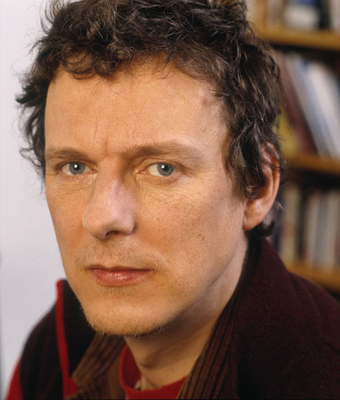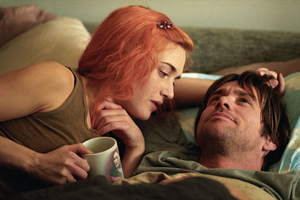BY DADE HAYES
 Photo by Robin Holland
Photo by Robin HollandMichel Gondry has no quarrel with CGI. The French filmmaker, known for Eternal Sunshine of the Spotless Mind and an array of mind-tickling commercials (Levi's, Nike) and music videos (Foo Fighters, White Stripes), has done his share of blue screen work. In fact, he is credited with inventing, in Björk's "Army of Me" video, a model for the "stop-motion" technique that made The Matrix an Oscar-winning touchstone.
But when he really gets the urge to create offbeat and specific tableaux, which is often, he prefers the old-fashioned, shoestring-and-chewing-gum approach to the wow-that-fur-looks-real computer route. His work is nevertheless a visual bounty, teeming with vividly sardonic or lyrical flourishes–a necktied worker shouldering a car in a Beck video, the ocean eroding a house in Eternal Sunshine–achieved mostly through physical effects and trompe-l'oeil camera placement.
There has been no purer distillation of Gondry's style than his latest film, The Science of Sleep, which premiered at Sundance and was quickly snapped up for $6 million by Warner Independent Pictures. It charts the budding relationship between Stephane (Gael García Bernal), an eccentric left-brained draftsman who struggles to distinguish his dream life from reality, and his equally quirky neighbor Stephanie (Charlotte Gainsbourg).
Made for less than $10 million, the film has a distinctively hand-hewn look. It is the visual triumph of the id, marrying workaday images with outlandish fantasies which are projected in a homemade TV studio lined with egg crates. In addition to extensive animation, he uses low-tech elements such as cardboard cut-outs, cellophane and all sorts of knickknacks and found objects. In one sequence, Stephane engages his boss in a fight using bloated, four-foot-long hands. True to Gondry's vision, the big hands were designed as simple props–little more than cardboard, paint and glue. But on screen, they seem funny and uncannily evocative of dream logic.
"I try to explore everything that can be done," says Gondry in his singsong accent. "If I wanted a little guy to walk around on the floor, then I would just cut out a drawing I had done and make a little contraption with a piece of string and suspend him by his feet and I would put the camera where it would show him standing up."
Much of the inspiration has to do with life on the set, where Gondry engages both cast and crew in the process of capturing a mood or a moment. "A lot of times the computer allows a director to be a little bit more lazy and you don't have to commit while you shoot. I like to be part of the process of figuring out how we're going to do it."
As in Sunshine, Gondry takes a heady concept–the nature of dreams–and grafts it onto an affecting love story with personal roots. Sunshine was written by Charlie Kaufman, as was Gondry's first film, Human Nature; He wrote The Science of Sleep himself, which makes it even more autobiographical. In fact, he consulted an ex-girlfriend for advice about how Stephanie would stave off Stephane's advances. He also meticulously recreated on a soundstage in Paris the calendar publishing office where he toiled in the 1980s; the replica was exact enough that, he told a post-screening audience at Sundance, "I got so anxious when we first started shooting there, like I had to go back to work."
For Gondry, Sleep also marked an important reunion with cinematographer Jean-Louis Bompoint, with whom he shared an apartment in Paris in the early 1980s. "He was my film mentor," Gondry says. "He has an immense film knowledge. We shared the same camera together when we started."
 ODD COUPLES: Gael Garcia Bernal has a crush on Charlotte Gainsbourg in
ODD COUPLES: Gael Garcia Bernal has a crush on Charlotte Gainsbourg in
Science of Sleep.
 Kate Winslet and Jim Carrey are drawn together in Eternal
Kate Winslet and Jim Carrey are drawn together in Eternal
Sunshine of the Spotleess Mind (bottom). (Credits: Warner
Independent Pictures and Buena Vista Pictures Marketing)The duo realized Gondry's aesthetic vision by having no preconceived notions going in. It's not that Gondry frowns on storyboarding–his training is in art–but he prizes serendipity. "When a DP says, 'I think this scene should be more blue,' or 'when the character says this, it should be in red,' I never believed in that," Gondry says. "I heard an interview with Vittorio Storaro talking about it and it just seemed full of shit. I'm sure he's a great artist but I don't think things should be defined in such a simple way. I don't like movies when they dictate that all the characters should be red. It takes you out of it. I'd rather start from a real place and not have it look special from the beginning."
Although Gondry's thriving production services company, Partizan, handles plenty of digital intermediates, he finds the process "dangerous because you can take a little bit of sepia out or take out a bit of the red," he says. "I like in movies when each scene has its own color and tone. I don't want to control that. I like when each thing can breathe."
One way he keeps air and life in the frame is by using rear projection, a technique seen most often in older films during car chases and train trips. In the hands of Gondry, who was constantly fiddling with things as a child and whose grandfather invented an early music synthesizer called the Clavioline, the retro technique turns wondrously expressive.
"When I use back projection, I use all the problems to my advantage," Gondry explains. "I want the camera to be shaking and moving. I want the image to be shot through layers of glass and texture. And then I get something that's really organically incorporated, which you can never get with blue screen. And there is something more important, for the actor to participate in the magic. If I'm projecting something, with back-projection, the actor will react to what they're seeing and feel that they're part of something."
The 43-year-old auteur, reed-thin with a mop of light brown curls, is at a prolific peak. In addition to Sleep, which will open in late summer or early fall, a concert film he directed, Dave Chappelle's Block Party, opened earlier this month. It is his first documentary feature, chronicling an outdoor concert in Brooklyn featuring performances by Kanye West, Erikah Badu and the Fugees, all conceived and emceed by Chappelle, whose comedy bits are woven in throughout.
"I wanted to help Dave transform the project into a real movie," he says. "I mean, it's a documentary concept, but we shot on film and had a little back story about people coming to see the show and talking about that. It ended up being a good, warm feeling. I'm very proud of that."
In a way, music was Gondry's entry into filmmaking. As the drummer for a little-known pop group called Oui Oui, Gondry shot a video featuring band members nonchalantly walking through New York streets wearing tall, conical wigs.
While making Block Party, Gondry found he had been magically transported, as in one of his cinematic fantasies, to the musical big time, sitting in on drums with several of the acts.
"I always wanted to be the drummer of Kool & the Gang," he says, "but we played more like bullfrogs meet Talking Heads. It wasn't really funky. And now I got to play with all those guys, the most funky guys on the planet."
Another dream come true.